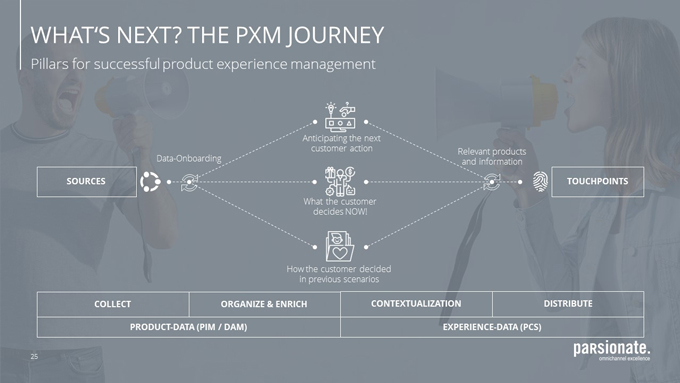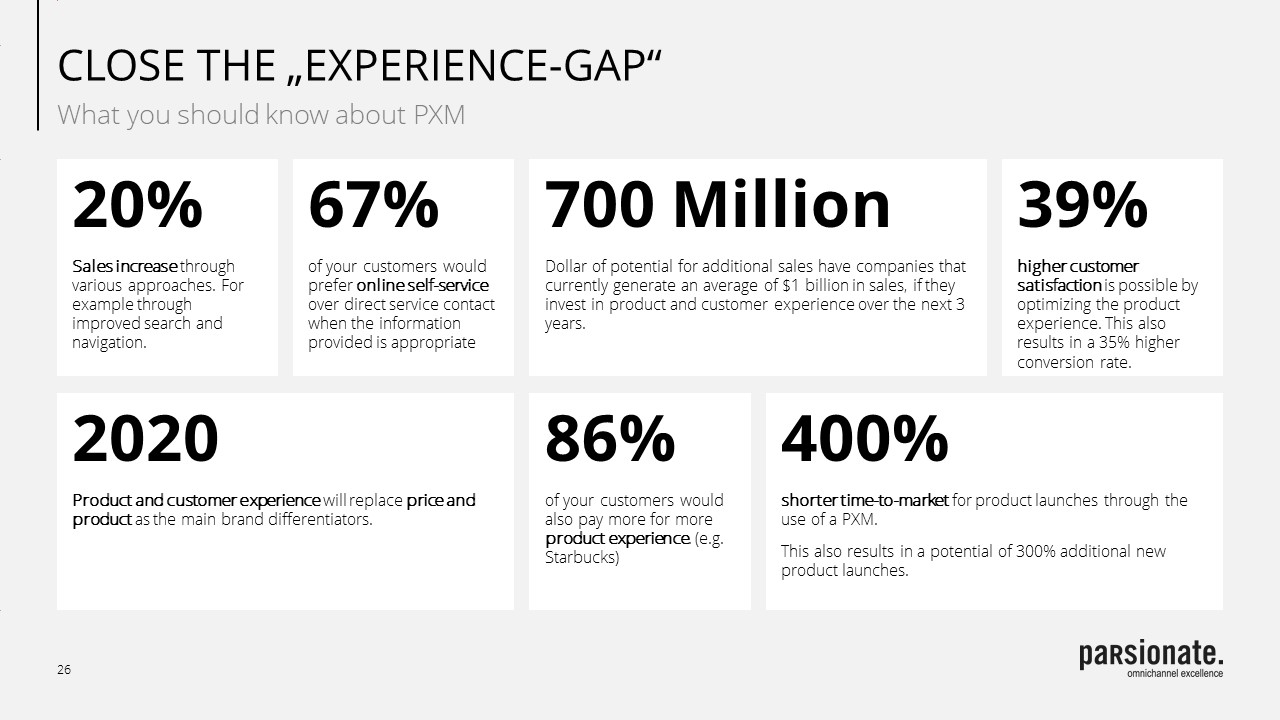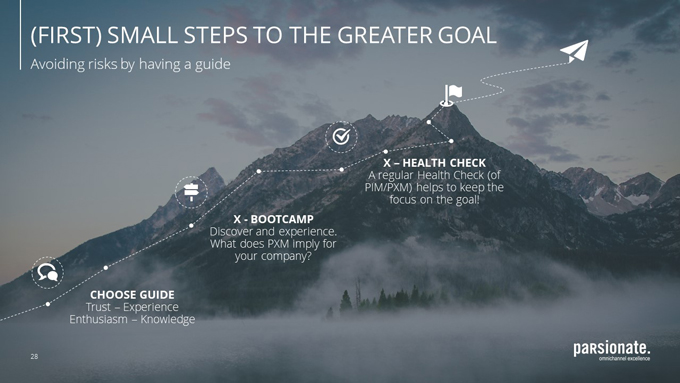Convincing Product Experience #2 – how can it be achieved?
Identifying the opportunities within the company and the benefits for the customer in order to offer a Product Experience is the first step into the right direction. The added value of a product or service offer can consist of an emotional purchase experience, quality, a service that can be booked in addition, time savings or a consultation. It is essential that the focus is directed primarily to the customer or the product.
 Laying the foundation for Product Experience also means looking inward. And that means turning to data management as a first step. Sales data from the sales department, such as sales figures and data from marketing, such as product descriptions or images, play just as an important role as technical information.
Laying the foundation for Product Experience also means looking inward. And that means turning to data management as a first step. Sales data from the sales department, such as sales figures and data from marketing, such as product descriptions or images, play just as an important role as technical information.
All available data is the "gold" of a company. The better a company handles this data, in terms of data quality and availability, the better it can, on the other hand, convert it into experience data and play it out.
Providing customer-relevant information that insists on high-quality data means "understanding the customer", "focusing on the customer", "recognizing customer preferences" – all the attributes that companies want to achieve from the customer's perspective. Which would then be reflected in product satisfaction and customer loyalty.
Regarding CX/PX we differentiate between three data types
- Operating data from the operational business,
- Product data and media assets,
- Experience data
Operating data is generated in daily business and is mainly related to the past. This includes master data (e.g. customer data, material data), transaction data (e.g. sales, returns rate, storage) and inventory data (e.g. stock and cash on hand, sales figures).
Product data and media assets are essential for the presentation of a product or service. These include textual descriptions (e.g. long texts, technical information, product features), category information and visual representations (e.g. video clips, images
In contrast, experience data helps to understand how the company is seen by its customers. This includes, for example, insights into the customer's experience and attitude towards a new product feature.
The great potential of digitization lies in linking these three types of data. Unfortunately, only a minority of companies today collect experience data, and even fewer link it with product or operational data. Even though the full economic potential can only unfold from this combination and useful, secure and high-quality insights can only be derived in context.
Only if you know what customers expect from the experience data, you can tailor the product data to this requirement. Based on sales figures (operational data), you can measure whether these activities meet customer expectations or whether they need to be re-adjusted.
No personal data = no individualization
In addition to the personal information that companies collect based on customer history (operational data), they have other data sources that indicate the interests of users in the shopping process:
- Which device the user is currently using: Device, operating system, browser
- Where the user is located: shopping center, university, residential area
- Where the user comes from: Facebook, Google, newsletter etc.
- When the user is looking for information: Weekday or daytime
Combining this data with artificial intelligence and machine learning makes it possible to derive certain patterns in the data sets. They provide information about the current situation of the user and enable a context-related approach in the current interaction. In other words, a customer surfing on his laptop on Sunday evening will see something different than on Monday morning when he is sitting in the subway with his smartphone.
Technical resources with which to present your products perfectly
The basis for successful PXM is to use available data in such a way that each customer experiences each product in a personalized way on their customer journey. Software tools support Product Experience management in different ways. In the following, we look at the technological key pillars.
 PXM can only be implemented if a complete basis for Product Data Management (Product Information Management, PIM) is created. This can be achieved if all data and digital assets are managed in a central system and this system can automatically output data through interfaces. In such systems (PIM and DAM), product data can be collected and processed in collaboration across different departments - as well as for different business requirements - and thus guarantee consistency in communication.
PXM can only be implemented if a complete basis for Product Data Management (Product Information Management, PIM) is created. This can be achieved if all data and digital assets are managed in a central system and this system can automatically output data through interfaces. In such systems (PIM and DAM), product data can be collected and processed in collaboration across different departments - as well as for different business requirements - and thus guarantee consistency in communication.
Product Content Syndication (PCS), on the other hand, is about the distribution of product data feeds across different e-commerce sales platforms and marketplaces while meeting the various requirements. In other words, it serves to synchronize product data over different touch points or points of contact and ensures the personalized, context-sensitive and, above all, targeted delivery of product data to relevant channels at the right time - for the customer for whom the information is relevant. This is where the change from product data to experience data takes place.
However, this can only happen if customer data is reliably collected within the company (so-called data onboarding). Not until then can customer needs be linked with the company's own product data. The division of data processing into three stages shows the optimal procedure.
- Insights were collected (past)
- How did the customer decide in previous cases?
- At which touchpoint did he decide to make the purchase?
- Insights are collected (present)
- How does the customer decide now?
- Evaluation of for example recommendation engines in the store
- Storage of the customer’s click path or search entries
- Insights will be forecasted (predictive – the supreme discipline)
- How will the customer decide in the future?
- The use of Artificial Intelligence and Machine Learning to predict the reaction of a customer
The stored personas and target groups, defined based on the individual customer needs, create a personal and emotional approach.
The information on the respective product must be complete, always up-to-date and enriched with media such as images and video clips in the PIM for an eventful presentation. This is the only way a product can be presented to the customer on a silver platter and presented in the best possible light. THE fundamental requirement for an eventful Product Experience.
What is the point?
In terms of ROI calculation of a PIM system (which is the starting point in the management of product data), the question is not: How much does the system cost? But rather: What does it cost not to have a PIM? Today, companies need to manage their product data to deliver quality and output to the right channels at the right time and in the right context. Otherwise, they will be left behind by the competition and not be noticed by the target group.
Here are some facts and figures from data management

Now you know the basis. Do you have the tools to get started with PXM?
 Is Product Experience Management a hype or a game changer? Neither one nor the other, we say - because the topic is already among us and in progress. It is not science fiction, but rather has already become reality, because the competitive situation on the market is already raising customer expectations that need to be fulfilled. Companies should start now and build the necessary basis for this.
Is Product Experience Management a hype or a game changer? Neither one nor the other, we say - because the topic is already among us and in progress. It is not science fiction, but rather has already become reality, because the competitive situation on the market is already raising customer expectations that need to be fulfilled. Companies should start now and build the necessary basis for this.
As parsionate, we can support you every step of the way and evaluate a customized technology together. You can also try it out in our X-Bootcamp: What does PXM mean for my company? If you already have a PIM system, parsionate offers health checks to determine the current state of processes, data and technologies in your existing system.
Michael Kugler and his team of experts offer consulting and implementation services with a focus on marketing and sales processes for manufacturers and retailers. The main areas of focus is “product experience”, “customer-centricity” and "omnichannel commerce" issues that play a significant role in digital transformation.
Do you want to learn more about product experience? Feel free to contact us! Our experience team will be happy to advise you.